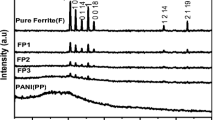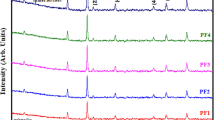Abstract
The electrical and networking industries are increasingly reliant on high-frequency ferrite nanocomposites, which are produced using ferrite and a polyaniline binder. In the present study, polyaniline is prepared by in-situ, while the ferrite is synthesized by adopting sol-gel process. The X-ray diffraction (XRD) analysis showed that all the samples (except PANI) possessed spinel structure. When spinel ferrite is blended with the polymer matrix, the crystallite size increased from 19 nm to 61 nm. Combining polyaniline with ferrites leads to a decreasing trend in the dielectric parameters (ε‘, ε“). Hysteresis loop analysis was conducted to evaluate the materials’ ferromagnetic properties. The saturation magnetization (Ms), remanent magnetization (Mr), and coercivity (Hc) all increased as the concentration of ferrite has been increased. The direct current (dc) resistivity and activation energy of a sample containing ferrites and polyaniline also increased. These all parameters suggested that FP-4 may be suitable for high-frequency applications.
Graphical Abstract

It illustrates that the dc resistivity of all samples are directly related to temperature, as heat causes charge carriers to move more. At room temperature, ferrites conduct electricity due to defects, but at a certain temperature, their primary mode of conductance is polaron hopping. The Verwey’s hypothesis explains that ferrites conduct electricity because electrons hop from one ion of the identical element to another that is randomly distributed across several crystalline lattice sites and has a different valence electron configuration.
Highlights
-
Ferrite and polyaniline samples were used to synthesize the nanocomposites using the sol-gel/in-situ technique.
-
X-ray diffraction analysis revealed that the spinel crystals had a crystallite size of 19–61 nm.
-
An increase from 25 emu/g to 52 emu/g in saturation Ms and an increase from 19 to 219 Oe in coercivity were observed, when the amount of spinel increases in the nanocomposite.
-
The dielectric characteristics were frequency-dependent at lower frequencies, but frequency-invariant at higher frequencies.







Similar content being viewed by others
Data availability
Data will be made available on reasonable request.
References
Gupta N, Paramsothy M (2014) Metal-and polymer-matrix composites: functional lightweight materials for high-performance structures. JOM 66(6):862–865
Yao HB, Fang HY, Wang XH, Yu SH (2011) Hierarchical assembly of micro-/nano-building blocks: bio-inspired rigid structural functional materials. Chem Soc Rev 40(7):3764–3785
Njuguna J, Ansari F, Sachse S, Rodriguez VM, Siqqique S, Zhu H (2021) Nanomaterials, nanofillers, and nanocomposites: types and properties. In Health and environmental safety of nanomaterials, Elsevier, Amsterdam, Netherlands, (pp. 3–37)
Ramesh M, Kumar N, Mandal AK, Singh RK (2020) The role of technology in environmental conservation. Nature 100:200–215. https://doi.org/10.1038/nature12345
Yao Z, Lin H, Zhou J, Haidry AA (2018) The effect of polymerization temperature and reaction time on microwave absorption properties of Co-doped ZnNi ferrite/polyaniline composites. RSC Adv 8:29344–29355
Dhand C, Das M, Datta M, Malhotra BD (2011) Recent advances in polyaniline based biosensors. Biosens Bioelectron 26:2811–2821
Bavatharani C, Muthusankar E, Wabaidur SM, Alothman ZA, Alsheetan KM, mana AL-Anazy M, Ragupathy D (2021) Electrospinning technique for production of polyaniline nanocomposites/nanofibres for multi-functional applications: a review. Synth Met 271:116609
Hosseinia SH, Zamanib P (2014) In situ synthesis and characterization of SrTiO3/SrFe12O19/Polyaniline core–shell nano composites and its investigation of microwave absorbing properties.
Jaime-González J, Mazario E, Menendez N, Sanchez-Marcos J, Muñoz-Bonilla A, Herrasti P (2016) Comparison of ferrite nanoparticles obtained electrochemically for catalytical reduction of hydrogen peroxide. J Solid State Electrochem 20:1191–1198
Nakamura T (2000) Snoek’s limit in high-frequency permeability of polycrystalline Ni–Zn, Mg–Zn, and Ni–Zn–Cu spinel ferrites. J Appl Phys 88:348–353
Khafagy RM (2011) Synthesis, characterization, magnetic and electrical properties of the novel conductive and magnetic Polyaniline/MgFe2O4 nanocomposite having the core–shell structure. J Alloy Compd 509:9849–9857
Ting TH, Yu RP, Jau YN (2011) Synthesis and microwave absorption characteristics of polyaniline/NiZn ferrite composites in 2–40 GHz. Mater Chem Phys 126:364–368
Gabal MA, Hussein MA, Hermas AA (2016) Synthesis, characterization and electrical conductivity of polyaniline-Mn0. 8Zn0. 2Fe2O4 nano-composites. Int J Electrochem Sci 11:4526–4538
Cushing BL, Kolesnichenko VL, O’connor CJ (2004) Recent advances in the liquid-phase syntheses of inorganic nanoparticles. Chem Rev 104:3893–3946
Lee SP, Chen YJ, Ho CM, Chang CP, Hong YS (2007) A study on synthesis and characterization of the core–shell materials of Mn1− xZnxFe2O4–polyaniline. Mater Sci Eng: B 143:1–6
Raju P, Neelima P, Rani GN, Kanakadurga M (2021) Enhanced microwave absorption properties of Ni0.48Cu0.12Zn0.4Fe2O4+polyaniline nanocomposites. J Phys Chem Solids 154:110048
Gunes M, Ozenbas M (2015) Effect of grain size and porosity on phonon scattering enhancement of Ca3Co4O9. J Alloy Compd 626:360–367
Wu WL, Wallace WE, Lin EK, Lynn GW, Glinka CJ, Ryan ET, Ho HM (2000) Properties of nanoporous silica thin films determined by high-resolution x-ray reflectivity and small-angle neutron scattering. J Appl Phys 87:1193–1200
Liu M, Younes H, Hong H, Peterson GP (2019) Polymer nanocomposites with improved mechanical and thermal properties by magnetically aligned carbon nanotubes. Polymer 166:81–87
Heidari EK, Ataie A, Sohi MH, Kim JK (2015) NiFe2O4/graphene nanocomposites with tunable magnetic properties. J Magn Magn Mater 379:95–101
Kechrakos D, Trohidou KN (2003) Competition between dipolar and exchange interparticle interactions in magnetic nanoparticle films. J Magn Magn Mater 262:107–110
Dobák S, Füzer J, Kollár P, Fáberová M, Bureš R (2017) Interplay of domain walls and magnetization rotation on dynamic magnetization process in iron/polymer–matrix soft magnetic composites. J Magn Magn Mater 426:320–327
Abbas SM, Dixit AK, Chatterjee R, Goel TC (2007) Complex permittivity, complex permeability and microwave absorption properties of ferrite–polymer composites. J Magn Magn Mater 309:20–24
Kumari N, Kumar V, Singh SK (2015) Structural, dielectric and magnetic investigations on Al 3+ substituted Zn-ferrospinels. RSC Adv 5:37925–37934
Gandhi N, Singh K, Ohlan A, Singh DP, Dhawan SK (2011) Thermal, dielectric and microwave absorption properties of polyaniline–CoFe 2O4 nanocomposites. Compos Sci Technol 71:1754–176
Devi DSP, Bipinbal PK, Jabin T, Kutty SKN (2013) Enhanced electrical conductivity of polypyrrole/polypyrrole coated short nylon fiber/natural rubber composites prepared by in situ polymerization in latex. Mater Des 43:337–347
Batoo KM (2011) Study of dielectric and impedance properties of Mn ferrites. Phys B: Condens Matter 406:382–387
Singh N, Agarwal A, Sanghi S (2011) Dielectric relaxation, conductivity behavior and magnetic properties of Mg substituted Zn–Li ferrites. Curr Appl Phys 11:783–789
Ajmal M, Islam MU, Ali A (2018) Structural, electrical and dielectric properties of hexa-ferrite-polyaniline nano-composites. J Supercond Nov Magn 31:1375–1382
Han K, Li Q, Chen Z, Gadinski MR, Dong L, Xiong C, Wang Q (2013) Suppression of energy dissipation and enhancement of breakdown strength in ferroelectric polymer–graphene percolative composites. J Mater Chem C 1:7034–7042
Abdullah MH, Yusoff AN (1997) Frequency dependence of the complex impedances and dielectric behaviour of some Mg-Zn ferrites. J Mater Sci 32:5817–5823
Nelson J (1999) Continuous-time random-walk model of electron transport in nanocrystalline TiO 2 electrodes. Phys Rev B 59:15374
Sekulic DL, Lazarevic ZZ, Sataric MV, Jovalekic CD, Romcevic NZ (2015) Temperature-dependent complex impedance, electrical conductivity and dielectric studies of MFe2O4 (M= Mn, Ni, Zn) ferrites prepared by sintering of mechanochemical synthesized nanopowders. J Mater Sci: Mater Electron 26:1291–1303
Hashim M, Kumar S, Shirsath SE, Kotnala RK, Shah J, Kumar R (2013) Synthesis and characterizations of Ni2+ substituted cobalt ferrite nanoparticles. Mater Chem Phys 139:364–374
Aziz B, Shakoor A, Qureshi AK, Ali K, Niaz NA, Farid MT, Ali I (2018) Structural, electrical, and magnetic properties of ferrite–polymer composites. J Electron Mater 47:6437–6442
Farid MT, Ahmad I, Kanwal M, Murtaza G, Hussain M, Khan SA, Ali I (2017) Synthesis, electrical and magnetic properties of Pr-substituted Mn ferrites for high-frequency applications. J Electron Mater 46:1826–1835
Farid MT, Ahmad I, Kanwal M, Murtaza G, Ali I, Khan SA (2017) The role of praseodymium substituted ions on electrical and magnetic properties of Mg spinel ferrites. J Magn Magn Mater 428:136–143
Dunlop DJ (1974) Thermal enhancement of magnetic susceptibility. J Geophys 40:439–451
Hochepied JF, Pileni MP (2000) Magnetic properties of mixed cobalt–zinc ferrite nanoparticles. J Appl Phys 87:2472–2478
Qindeel R, Alonizan NH (2019) Improved structural and magnetic properties of polypyrrole substituted spinel ferrites composites. Mater Sci Eng: B 244:43–48
Xie J, Han M, Chen L, Kuang R, Deng L (2007) Microwave-absorbing properties of NiCoZn spinel ferrites. J Magn Magn Mater 314:37–42
Aman S, Tahir MB, Ahmad N (2022) Study of Europium substituted spinel ferrites for microwave devices. J Mater Sci: Mater Electron 33:21995–22006
Hanson AJ, Belk JA, Lim S, Sullivan CR, Perreault DJ (2016) Measurements and performance factor comparisons of magnetic materials at high frequency. IEEE Trans Power Electron 31:7909–7925
Fu YP, Hung DS, Yao YD (2009) Microwave properties of chromium-substituted lithium ferrite. Ceram Int 35:2179–2184
Acknowledgements
This research work was funded by Institutional Fund Project under grant no. IFPHI-271-130-2020. Therefore, the authors gratefully acknowledge technical and financial support from the Ministry of Education and King Abdulaziz University, DSR, Jeddah, Saudi Arabia.
Author’s contribution
All the authors have contribution in the work and they are known with the submission.
Author information
Authors and Affiliations
Corresponding authors
Ethics declarations
Conflict of interest
The authors declare no competing interests.
Additional information
Publisher’s note Springer Nature remains neutral with regard to jurisdictional claims in published maps and institutional affiliations.
Rights and permissions
Springer Nature or its licensor (e.g. a society or other partner) holds exclusive rights to this article under a publishing agreement with the author(s) or other rightsholder(s); author self-archiving of the accepted manuscript version of this article is solely governed by the terms of such publishing agreement and applicable law.
About this article
Cite this article
Donya, H., Darwesh, R., Alotaibi, M.F. et al. A comparative study of spinel ferrites/PANI composites for high-frequency applications. J Sol-Gel Sci Technol 108, 695–703 (2023). https://doi.org/10.1007/s10971-023-06233-4
Received:
Accepted:
Published:
Issue Date:
DOI: https://doi.org/10.1007/s10971-023-06233-4




